Bobby Jones
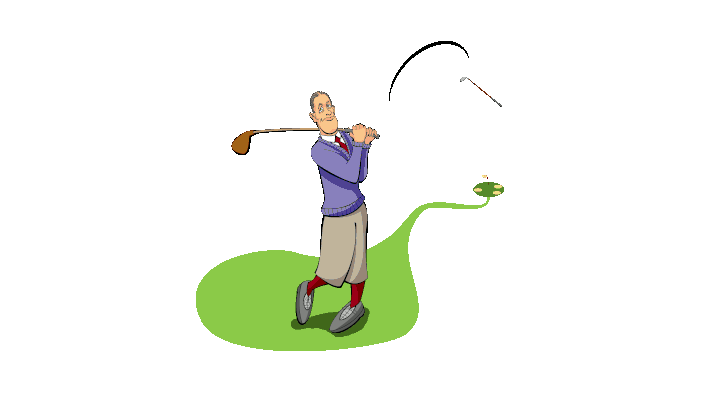
(Click on the image to zoom in and out.)
| "I think we were the first to use slow motion." | |
| ‐ | Al Barkow, Shell's Wonderful World of Golf. |
Actually, that's not quite true. Shell's Wonderful World of Golf was certainly one of the early golf shows to use slow motion to illustrate how golf shots work. But it wasn't the first. That honor went to a series of short videos - then called "films"1 - titled How I Play Golf which was produced in 1931. These films were hosted by Mr. Robert Tyre Jones.
Footnote
For those of tender ages, early motion pictures were literally recorded on film - thin strips of plastic where sequential images were printed and when run through a light projector produced the illusion of motion. Language of old technology - such as "cut and paste", "files", "folders", and yes, "films" - remain alongside the new technology although gradually new language - like "videos" - takes over.
Bobby (as his friends called him) was an amateur golfer who ...
Hah? (To quote Shakespeare.2) Did you say that
Bobby Jones
who some call
THE GREATEST GOLFER
OF ALL TIME
was an
 AMATEUR?
AMATEUR?
Indeed.3 Bobby Jones never turned pro. This was, we must point out, his choice. But he competed and even excelled against the pros in the open tournaments - that is tournaments where both professional and amateur players compete on equal standing - and it was in 1930 that he made the "Grand Slam" when he cleaned up at the British Amateur Championship, (at St. Andrews), The [British] Open Championship (Hoylake, UK), The U.S. Open (Edina, Minnesota), and The U.S. Amateur (Merion, Pennsylvania).4
Footnote
Today the "Grand Slam" is winning in a single year the Masters Tournament (always played in Augusta, Georgia), The U.S. Open, The Open Championship (at the Royal St George's Golf Club in Sandwich, England), and the PGA Championship.
In addition to Bobby, four other amateurs have won the US Open: Francis Ouimet (1913), Jerome Travers (1915), Chick Evans (1916), and John Goodman (1933). But Bobby stands out as he won the tournament four times: 1923, 1926, 1929, and finally in 1930. Three other men, all professionals, have equaled but never exceeded that number: Willie Anderson (1901, 1903, 1904, 1905), Ben Hogan (1948, 1950, 1951, 1953), and Jack Nicklaus (1962, 1967, 1972, 1980).
Other than Bobby, two amateurs have won the British Open (usually called The Open Championship): John Ball in 1890 and Harold Hilton in 1892 and 1897). Bobby won the tournament in 1926, 1927, and 1930. And as the numbers attest, no amateur has won the tournament since Bobby.
After the year of the Grand Slam, 1930, Bobby retired from active competition. He was only 28. By today's standards, this is young for a golfer to hang up his duffle. For comparison Sam Snead with his famous straw fedora won his last professional tournament in 1965, at age 52, and retired in 1985 when he was 73.
The year after he retired Bobby began making his instructional films. Collected into two series, How I Play Golf and How To Break 90, the videos are still popular and useful for the aspiring golfer. There are, though, some caveats.
Appearing with Bobby ...
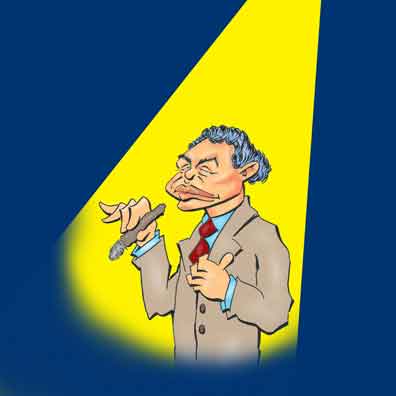
Edward...

... Joe E. ...
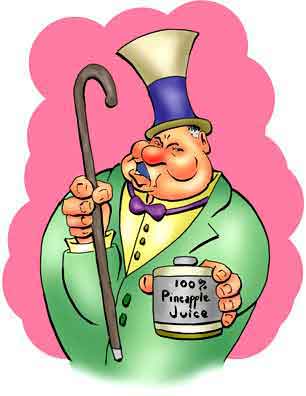
... Bill ...
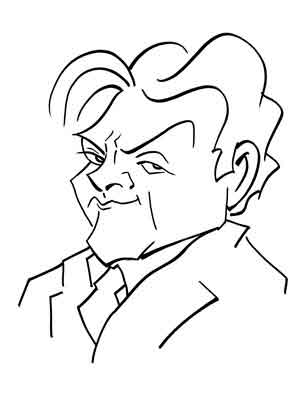
... James ...

... and Joan.
For one thing to make the films entertaining, sometimes there was a "story" behind each episode which featured then famous actors like Edward G. Robinson, Joe E. Brown, W. C. Fields, James Cagney, and Joan Blondell. The humor is a also bit dated and the plots involve crotchety fathers who call the cops when their 20-something daughters run off to get married, wives nagging their husbands about playing too much golf, and "dippy" motormouthed blondes whose non-stop chattering interferes with making the films.
Also the apparel worn on the links may raise a few eyebrows. The golfers - almost all men - are gussied up in ties, jackets, sweaters, and slacks and sometimes sporting "plus fours" which are baggy trousers that end below the knees and are worn with long socks. Even a group of kids who stop by and ask Bobby if he can give them some pointers are "dressed up for golf".
The films used special effects which were state of the art for the 1930's. One effect was showing the ball fly by and almost brushing the side of the camera view and at one time actually hitting the lens. We must question whether even Bobby could hit a ball with that accuracy.
As we said, these films sometimes show Bobby's golf swings in slow motion. Slow motion was achieved using special cameras where the filming was at a higher speed and so when played at standard projection rates the action was slowed down.5 This method produces smoother motion and sharper images than what you often see today by slowing down the projection of a video recorded at normal speed.
Footnote
Slow motion cameras were expensive. In early films having scenes with buildings collapsing or volcanoes erupting were made by filming small scale models in slow motion. But low budget productions that couldn't afford the high-speed cameras had to come up with alternative methods for the effect. In his early films Ray Harryhausen would suspend parts of whatever was collapsing or exploding by wires and then reposition them and film in stop-motion.
Today, of course, high speed digital cameras are available. There are also digital processing methods that make for smooth slow motion even if the initial speed of the cameral is normal.
What may cause amused perplexity for the beginning golfer is the names of the clubs. Yes, the names. Although when Bobby was playing the game, drivers were still drivers and the putters were putters, the 2 and 3 woods were a brassie and a spoon, and the 4 wood was variously dubbed a baffy, baffie, baffing spoon or wooden cleek. The irons also had names and not numbers. The 1 iron was called (as today) a driving iron, but also a cleek.
Moving on up, the 2 iron was a mid-iron, the 3 iron a mid-mashie, the 4 iron a mashie iron or a jigger, and the 5 iron was simply a mashie. The 6 iron was a spade mashie and the 7 iron a mashie niblick. That pretty much takes care of the mashie family.
Reaching the eight iron we have the lofting iron and the nine iron was a niblick. What is called the wedge today was either named a pitching niblick, a jigger (confusingly the same as the 4 iron), or a chipper. The putter, as we said, was simply a putter.
As to when the names switched to numbers, like all natural processes it occurred over time. Certainly by the 1950's when golf tournaments had become regular staples for television audiences, you would hear the modern numbers with scarce a reference to a brassie, mashie, or niblick.
On the other hand, by the late 1950's there was still some retention of the older names. In the famous golf game portrayed in the 1959 James Bond novel Goldfinger, Bond and Goldfinger are still using "brassies" and "spoons" but are also selecting 4 irons rather than mashie irons. After making a bad shot, Bond wondered why the [heck] he hadn't taken a 2 iron rather than a 4 wood for a shot. We really can't expect Secret Agent 007 to question why he hadn't chosen a baffy, baffie, baffing spoon, or wooden cleek.
Of course, Goldfinger tries to cheat by improving his lie, rattling coins in his pockets, having his shadow pass over Bond's ball, dropping his club just as Bond is taking a swing, and paying his caddy to drop a new ball down his trouser leg when Goldfinger's drive gets lost in the rough. Bond finally wins by out-cheating the cheater.
The modern equivalents to the old names must needs have be approximate. Clubs and the attendant technology has changed. In the early days golf clubs were hand crafted and so there was far less consistency with the individual clubs. Some designs, such as the angle of the faces which affects the loft of the ball, have also varied over the years and some of the old clubs would not even be permitted in modern tournament play.
And of course, today "woods" - as they are still called - are made of metal, and because hollow metal clubs made from titanium are lighter than solid wood clubs (usually persimmon), the heads can be made larger. This makes it easier to hit the ball, and the clubs can also be made longer which sends the balls greater distances. More recently carbon fiber has been used for making both the shafts and in the heads.
Bobby was born in Atlanta, Georgia, in 1903. Hearing him speak is most refreshing as it proves that you can be articulate without speaking Hollywood crafted Midwesternese. In his instructional films, he explains his points clearly so that even the neophytic golfer can understand what Bobby means.
One of Bobby's earliest films, though, was silent. So rather than an announcer or Bobby doing the explaining, you have to learn what's going on by reading the title cards. Strange to modern viewer is Bobby's name is always put in quotes, "Bobby". It was a more formal time.
If the Jones family wasn't wealthy, it was certainly comfortably middle class and Bobby showed his golfing ability early (his dad was also a capable player). Almost from the first Bobby was winning kids tournaments, and he won his first real championship, the Georgia Amateur, at age 14. That got him to the U. S. Amateur, and by eighteen he was competing with the pros.
Bobby has always been represented as the quintessential sportsman. That's true enough. Once a ball was driven into the trees and as he stood to make the next shot the club accidentally touched the ball. No one was around him but he stepped out of the grove and signaled he should be given a penalty stroke. Praised for his sportsmanship he snorted that you might as well praise a man for not robbing a bank.
Sportsman though he was, Bobby enjoyed what were considered the pleasures of the day. According to one account he smoked over three packs of cigarettes during a single match with Walter Hagen.6 He was also quite fond of a nip despite Prohibition being in effect and with élan would down moonshine as well as martinis. There's a story that when he was assistant manager of the golf team at Harvard7, one of his duties was making sure there was plenty of refreshment taken along. But when everyone got to the destination, there wasn't any left for the rest of the team.
Footnote
Another smoker during matches was Jack Nicklaus. However, he gave it up after realizing it wasn't a good example for the kids.
Footnote
Because he had been on the golf team at Georgia Tech, Bobby wasn't eligible to play on the golf team during his later studies at Harvard. Although there was already a manager for the team - that is a student who helped with the equipment and the logistics of the matches - he volunteered to be assistant manager, an offer that was accepted.
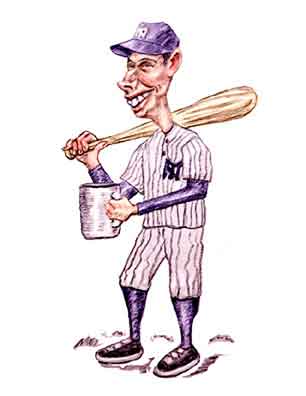
Joe
Marketable
We said that Bobby never turned pro. Actually, that's only true regarding the tournaments. When he retired Bobby, like Joe Dimaggio, realized he was a marketable commodity. The instructional videos provided considerable income - $100,000 by one account8 - and he began to market golf equipment. Because he was accepting money associated with golf, he could no longer keep his amateur standing.9
Footnote
Although the criteria have loosened up considerably, up to the mid-20th century amateurs could accept no money in any form with even tangential association with the games. Well into the 1970's, amateurs had to donate any prize money even if they appeared as contestants on television quiz programs, for crying out loud!
There is the story that in England Bobby actually bet on himself that he would win the Grand Slam. Bookmaking was (and is) permitted in England and so what Bobby did was perfectly legal. Reportedly he cleaned up £60,000. Sadly (or perhaps fortunately) documentation for this story is not readily found. Certainly Bobby's lucrative wager isn't mentioned in one of the more recent academic biographies.
But like many sports figures Bobby picked up some good change with endorsements. After winning the Grand Slam and when How I Play Golf began running in the theaters,10 a single page of a newspaper might contain multiple ads for products plugged by Bobby which ranged from golf shoes to ice cream and to "Chief Two Moon's Bitter Oil" which the polite might call an herbal medicine but the somewhat crass would label a laxative.
Footnote
Hard to believe when you can see videos, including full-length motion pictures, on devices held in the hand and carried in a pocket, there once was a time you had to go into theaters to see a film. Bobby's instructional films were shown as preliminaries to feature films much as were newsreels, cartoons, and "shorts" which were 15-30 minute films, usually comedies, featuring the likes of Laurel and Hardy, Our Gang (i. e., The Little Rascals), and The Three Stooges.
Like many great golfers, Bobby decided he might want to design some courses that were, not necessarily easy to play, but built on the actual logic of golf. And with more courses came more tournaments to get more duffers out on the links. Probably his greatest legacy apart from his wins and sportsmanship is the design and founding of the Augusta National Golf Club with its Masters Tournament in his home state. The Masters with its attendant green jacket is probably now THE tournament to win.
There's a difference between an open tournament and a pro-am. An open tournament is open to professionals and amateurs but they compete on an equal footing. Also the entrance requirements are tough - the U. S. Open mandates all contestants must have a handicap of less than 1.4. And in the play whether pro or amateur no scores are handicapped. You get what you shoot.
A pro-am on the other hand is played by teams where you have at least one professional assigned to a group of amateurs. Usually it's one professional to three or four amateurs and the amateurs are allowed to use their handicaps. The lowest score for a hole is selected for the team. If it is evident that anyone playing more shots will not improve the score, the player "picks up" and doesn't complete the hole.
The main exception to the 3-4:1 amateur:pro ratio is the AT&T Pebble Beach Pro-Am, formerly the Bing Crosby National Pro-Amateur. At this tournament each professional is paired with one amateur. Again the score is collective with the lowest score on the hole counting and includes the handicaps of the amateurs.
In principle having a high handicap is no, well, no handicap, and such "ham and egging" the score (as one professional called it) can lead to particularly low scores for the team. For instance, writer George Plimpton played in the 1966 Crosby Tournament, and with his 18 handicap, his score on each hole would average one less than par. So if he made a par, then he made a birdie. Sometimes a team with a player with a high handicap can do particularly well if the high handicapper has a good day.
The professionals are also allowed to compete on their individual score to make the "cut" for the final round. So if the team doesn't qualify for the final day's play, the professional could still play if his personal score put him inside the cut - usually a pre-designated number of players with the lowest scores.
Although open tournaments have strict qualifications, in the pro-ams many of the slots for the amateurs are by invitation and reserved for celebrities regardless of their golfing prowess. Many professionals also play by invitation and some top golfers may automatically qualify based on their scores in recent tournaments. The few remaining slots for both amateurs and pros are decided by a qualifying round.
Bobby was also known for his temper and if ladies weren't present he could swear with the best of them. As a young golfer he was known to hurl clubs - particularly his "Calamity Jane" putter - if a shot went awry. With wooden shafts a broken club often was the result. His dad expressed concern to Bobby's teachers but they said not to worry. He'd learn to control his temper and focus the energy into the game. That's pretty much what happened and although Bobby quit tossing clubs during tournaments, when playing for relaxation he might hurl an errant baffy, baffie, baffing spoon, wooden cleek, mid-mashie, mashie iron, jigger, mashie, niblick, pitching niblick, or a chipper if he thought the club's performance merited it.
But even the best of them need assistance and before the 1925 National Open in Wooster, Massachusetts, Bobby was having difficulty with his drives. He called his old teacher from Atlanta, Stewart Maiden, for help. Stewart lived in Atlanta and took the train to Massachusetts. He watched Bobby take some swings on the practice tee. Stewart then said, "Why don't you try hitting the ball with your backswing?". He then turned around and took the train back to Atlanta. Bobby got the message, slowed down his swing, and managed to come in second in the tournament after a playoff round.
Ranked with Bobby Even Today

Jack

Babe
As you may expect, Bobby had many honors thrown his way, and his name was listed among the five great sports celebrities of the early 20th Century. The others were Babe Ruth (baseball, of course), Jack Dempsey (boxing), Red Grange (football), and Bill Tilden (tennis). From this Big Five, today most people only remember Babe, Jack, and Bobby.
Bobby also had his portrait painted at the request of the Augusta National Golf Club. Many people have seen the painting created by an artist whose first name rhymed with "like". Many have praised the picture for it's excellent likeness and composition - amazing as it was painted by an "amateur" - both as a painter and a golfer.
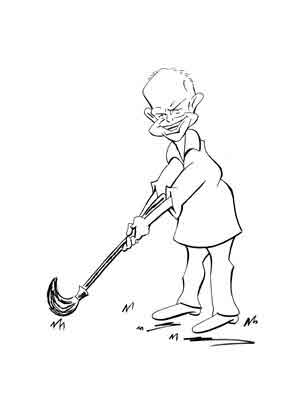
Rhymes with "Like".
Actually Ike's painting is a really a copy. The original hangs in the Bobby Jones Collection at the United States Golf Association Museum and Library in Liberty Corner, New Jersey and was by the Welsh painter Thomas Edgar Stephens (1886- 1966). As an artist, Thomas, we must point out, was a professional.
References
The Immortal Bobby: Bobby Jones and the Golden Age of Golf, Ron Rapoport, Wiley, 2005.
Jack Nickalas vs. Sam Snead Revisited/1963 Shell's Wonderful World of Golf, Sam Snead, Jack Nickalas, PGA Tour, 2022.
How I Play Golf, Bobby Jones, Vitaphone, Warner Brothers, 1931.
"Bobby Jones: How I Play Golf", Dave Coustan, How Stuff Works.
"The Masters, Privacy and a Remarkable Man", Scot Macdonald, Club Lender, April 02, 2018.
"5 Myths About Bobby Jones", Sidney Matthew, Links Magazine.
And Then Jack Said to Arnie, Don Wade, McGraw-Hill, 1992.
And Then Arnie Told Chi Chi, Don Wade, McGraw-Hill, 1994.
And Then Chi Chi Told Fuzzy, Don Wade, Contemporary Books, 1995.
"Names of Old Golf Clubs and Their Closest Modern Equivalents", Golf Today, February 8, 2018.
"Bobby Jones in 'Chip Shots'", The Waterbury Democrat, May 8, 1931, p. 17.
"Bobby Jones says 'You may be a good golfer, but you'll be a better one in a pair of these Golf Shoes'", The Waterbury Democrat, May 8, 1931, p. 17.
"See Bobby Jones in 'How I Play Golf'", The Waterbury Democrat, May 8, 1931, p. 17.
"SUPERIOR as Bobby Jones is To Golf", The Waterbury Democrat, May 8, 1931, p. 17.
"Bobby Jones says 'After a Hard Game of Golf a Good Dish of Ice Cream Certainly Hits the Right Spot'", The Waterbury Democrat, May 8, 1931, p. 17.
"Bobby Jones Himself: To Play Better Golf Or Excel in Any Sport or Outdoor Activity You Need a Healthy Body. Start Taking Chief Two Moon Bitter Oil Today", The Waterbury Democrat, May 8, 1931, p. 17.
The Bogey Man, George Plimpton, Harper and Row, 1967.